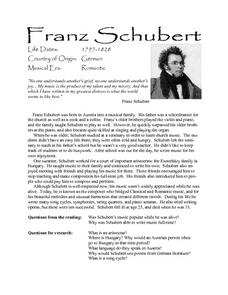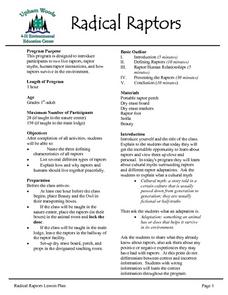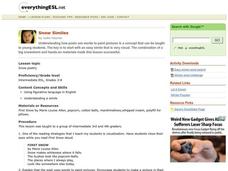Curated OER
Predicting Temperature: An Internet/Excel Learning Experience
Third graders use the Internet (www.weather.com) to find the high temperature for our locale and the high temperature for another city around the world. They keep track of the temperature in these two locations for 10 days.
Curated OER
Ocean Currents
Fourth graders work in groups to research ocean currents and create posters with their findings. They locate the patterns and names of major ocean currents and identify them on a map. Students also use red pencil to show ocean currents...
Curated OER
Structure of the Earth
Sixth graders examine the layers of the Earth and the changes that take place on a daily basis. They look at the layers of a boiled egg to relate them to the layers of the Earth.
Curated OER
Earth's History
Seventh graders study the law of superposition by creating models of fossils in layers of rock. They examine how fossils are usually found in sedimentary rock which leads to the study of geologic history in those rocks.
Curated OER
Japanese Culture
Seventh graders make connections with the history of Japanese art with the modern use of ancient warriors in the popular Yu-Gi-Oh trading cards. They journal and reflect upon the research and comparison of the ancient to modern art.
Curated OER
When is Humanitarian Intervention Justified?
Students analyze different foreign policies to derive their own idea of what constitutes appropriate intervention by a government. They complete a detailed proposal for their own Declaration of Human Rights.
Curated OER
Changing Images of Childhood in America: Colonial, Federal and Modern England
Students compare and contrast maps of New Haven, Connecticut from today and the past. After taking a field trip, they draw sketches of the types of architecture and discuss how the buildings have changed over time. They read journal...
Curated OER
Patterns
Fifth graders investigate the use of patterns in a data set. The set is disolayed visually using cubes. This helps struggling students to see the quantity in order to make comparisons more effectively.
Curated OER
Literature: It's a Mad, Mad Macbeth
Students determine how the themes expressed in Macbeth are also applicable to contemporary society. They complete a series of written assignments demonstrating their comprehension of theme, content, and interpretation of the play....
Curated OER
Which Animals Should Be Saved?
Fifth graders investigate the concepts related to the endangerment of different animal species. They conduct research using a variety of resources. The skills of prediction are used to show the possible outcome of the extinction of a...
Curated OER
Business Practices and Competition
Pupils identify the costs and benefits of large corporations and monopoly industries. Using the internet, they discover how businesses use different types of exploitation to maximize their profits. They read two articles about plants...
Curated OER
Oddity Rhyming Strips
Students practice identification of rhyming words. Students compare/contrast pictures by identifying rhyming sounds in them. Students place strips on the pictures. Students share comparisons with each other.
Curated OER
Advertising Through the Decades
Twelfth graders compare and contrast advertising styles and motives from 1920 to present. Using internet research and print advertisements students make comparisons and inferences about the function of marketing. At the culmination of...
Curated OER
Symphony No. 8 "Unfinished" by Franz Schubert
Students review vocabulary words and look at a piece of art work with one subject and play any or all of the familiar musical examples listed. They then identify the melody of each example and make a comparison between the art subject...
Curated OER
Radical Raptors
Students are introduced to raptors and their role in the environment. They identify three characteristics of raptors and list several types of raptors found in nature. They discuss their positive and negative experiences with raptors and...
Curated OER
Measuring and Comparing Weight and Capacity
First graders measure weight and capacity. In this measurement lesson, 1st graders explore visual examples of weight and capacity comparisons. Students also practice solving problems that their instructors model.
Curated OER
The Tell Tale Heart
Eighth graders explore storytelling by listening to a reading of a classic poem. In this language arts lesson, 8th graders listen to an audio recording of Edgar Allen Poe's The Tell-Tale Heart. Students examine the life of Poe by...
Curated OER
Gender-based Temperance Reform
Eleventh graders investigate the Temperance Reform Movement. In this primary source analysis lesson, 11th graders use the provided analysis sheet to analyze the contents of the article "Advice to Young Women and Young Men," published in...
Curated OER
Demystifying Stereotypes and Understanding Contemporary Cultures
Fourth graders compare and contrast folk songs from different cultures. In this music instructional activity, 4th graders listen to and list the attributes of selected Japanese and American folk songs. Students discover the customs,...
Curated OER
Taking Care of Your Teeth
First graders discuss the importance of taking care of their teeth while viewing pictures showing good/poor teeth care. In this health and science lesson, 1st graders list 3 things to do to keep teeth healthy, creating a lis on chart...
Curated OER
How Many Thousandths Are in Your Box?
Students identify the different place values. For this algebra lesson, students represent decimal place values with manipulatives. They identify the correct place value using commas and mathematical reasoning.
Beacon Learning Center
Twix-n-Tween
Yummy! Use Twix candy bars to teach a instructional activity in comparing length! Learners will love this instructional activity and you will be addressing Common Core standards at the same time!
Curated OER
GroWing Up
Students investigate a short biography of George Washington's childhood. They examine the differences between life for students in the eighteenth century and today.
Curated OER
Snow Similes
Students see how poets use words to paint pictures. The combination of a big snowstorm and hands-on materials make this lesson successful. There are some nice attachments that the students will really enjoy!

























